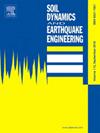An optimization suggestion for site classification scheme in Chinese seismic code based on clustering analysis of site amplification
IF 4.2
2区 工程技术
Q1 ENGINEERING, GEOLOGICAL
引用次数: 0
Abstract
There has been extensive discussion as to whether the scope of site classification II is too broad in current Chinese seismic code. To address this issue, this study aims to optimize the site classification scheme for Chinese seismic code using clustering analysis of site amplification. Firstly, we estimate the empirical site amplification factors of KiK-net stations by the residual analysis method, and classify them by the site classification scheme of Chinese seismic code. Next, we perform k-means clustering analysis on the stations of site class II, considering site amplification factors, equivalent shear wave velocities and thicknesses of sedimentary layers as explanatory variables, and obtain two clusters with distinct site amplification effects. Finally, we use correlation analysis and Receiver Operating Characteristic (ROC) curve to guide the optimization of site classification scheme, and suggest dividing site class II into two subclasses, IIa and IIb, by a threshold of 15m for the thickness of sedimentary layer. The proposed optimized classification scheme would be beneficial for improving the seismic design code and could be further applied to the development of ground motion models and seismic hazard analysis.
基于场地振幅聚类分析的中国地震规范场地分类方案优化建议
关于现行中国地震规范中场地分类 II 的范围是否过于宽泛的问题已引起广泛讨论。针对这一问题,本研究旨在通过对台站放大系数的聚类分析,优化中国地震规范的台站分类方案。首先,利用残差分析方法估算 KiK 网台站的经验台址放大系数,并按照中国地震台网规范的台址分类方案进行分类。其次,以场址放大系数、等效剪切波速和沉积层厚度为解释变量,对Ⅱ类场址台站进行 K-均值聚类分析,得到两个场址放大效应不同的聚类。最后,利用相关性分析和接收者工作特征曲线(ROC)来指导站点分类方案的优化,并建议以沉积层厚度 15 米为临界值,将站点Ⅱ类分为Ⅱa 和Ⅱb 两个子类。建议的优化分类方案将有利于改进抗震设计规范,并可进一步应用于地震动模型的开发和地震危险性分析。
本文章由计算机程序翻译,如有差异,请以英文原文为准。
求助全文
约1分钟内获得全文
求助全文
来源期刊

Soil Dynamics and Earthquake Engineering
工程技术-地球科学综合
CiteScore
7.50
自引率
15.00%
发文量
446
审稿时长
8 months
期刊介绍:
The journal aims to encourage and enhance the role of mechanics and other disciplines as they relate to earthquake engineering by providing opportunities for the publication of the work of applied mathematicians, engineers and other applied scientists involved in solving problems closely related to the field of earthquake engineering and geotechnical earthquake engineering.
Emphasis is placed on new concepts and techniques, but case histories will also be published if they enhance the presentation and understanding of new technical concepts.
 求助内容:
求助内容: 应助结果提醒方式:
应助结果提醒方式:


